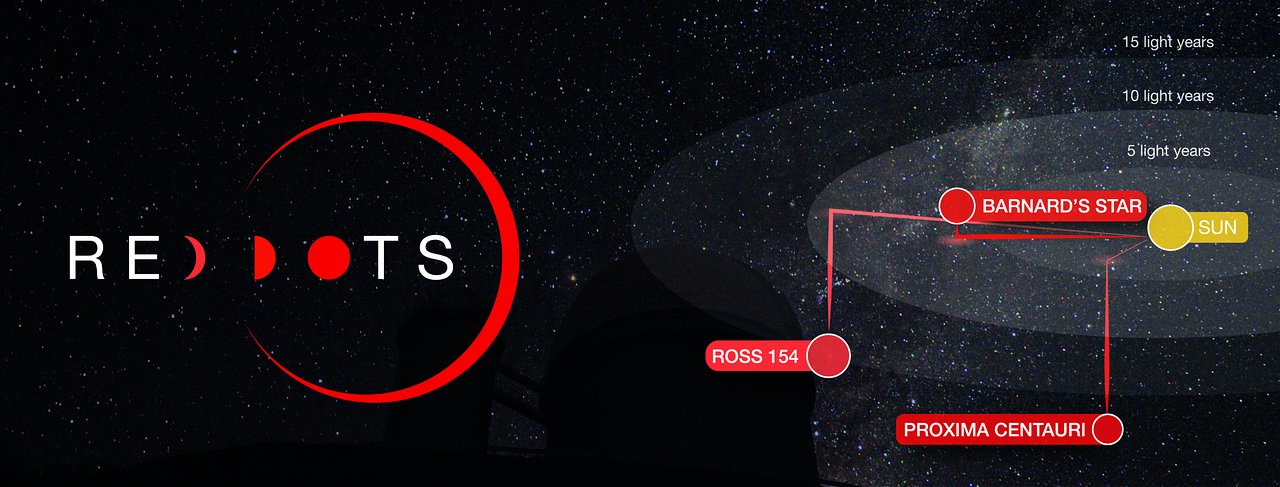Red Dots: The Live Search for Terrestrial Planets around Proxima Centauri Continues
The Red Dots campaign will show how astronomers look for planets around Proxima Centauri, Barnard star and Ross 154
The team behind the Pale Red Dot campaign, who last year discovered a planet around the closest star to our Sun, are resuming their search for Earth-like planets and launching another initiative today. The Red Dots campaign will follow the astronomers as they use ESO’s exoplanet hunter to look for planets around some of our nearest stellar neighbours: Proxima Centauri, Barnard's Star and Ross 154. ESO is joining this Open Notebook Science experiment — real science presented in real time — that will give the public and the scientific community access to observational data from at least Proxima Centauri as the campaign unfolds.
The scientific team [1] led by Guillem Anglada-Escude from Queen Mary University of London will acquire and analyze data from ESO’s High Accuracy Radial velocity Planet Searcher (HARPS) and other instruments across the globe [2] over approximately 90 nights. Photometric observations began on 15 June and spectrographic observations start on 21 June.
HARPS is a spectrograph with unrivalled precision — the most successful finder of low-mass exoplanets to date. Attached to the ESO 3.6-metre telescope at La Silla, HARPS searches nightly for exoplanets, looking for the minute wobbles in the star’s motion, generated by the pull of an exoplanet in orbit. HARPS picks up motions which can be as little as a gentle walking pace — just 3.5 km/h — from trillions of kilometres away.

Among the stars targeted by Red Dots will be Proxima Centauri, which scientists suspect has more than one terrestrial planet in orbit around it. Proxima Centauri is the closest star to our Sun, only 4.2 light-years away. It may be one of the most suitable places to look for life beyond our Solar System, as our instruments and technologies advance.
Earlier this year, ESO announced a partnership with Breakthrough Initiatives, which aims to demonstrate proof of concept for a new technology, enabling ultra-light unmanned space flight at 20% of the speed of light. Such nanocraft could be sent to the three stars of the Alpha Centauri system, of which Proxima Centauri is the closest to our Sun.
The other two stars observed during the Red Dots campaign are: Barnard's star, a low mass red dwarf almost 6 light-years away, and Ross 154, another red dwarf, 9.69 light-years away.
The telescope observations will be complemented by an outreach campaign supported by ESO and other partners [3]. The Pale Red Dot campaign revealed the methods and steps of doing science, but the results were presented only after the peer review process. This time, observational data from Proxima Centauri will be revealed, analyzed and discussed in real time.
Pro-am collaborations and contributions by interested citizens and scientists will be encouraged via social media and a forum tool where a more scientific and technical conversation will take place.
Any observations presented during this time will of course be preliminary only and they must not be used or cited in refereed literature. The team will not produce conclusive statements, nor claim any finding until a suitable paper is written, peer reviewed and accepted for publication.
The Red Dots campaign will keep the public informed via the reddots.space website, where weekly updates will be posted, together with supporting articles and highlights of the week including featured contributions by the community. Conversations will take place also on the Red Dots Facebook page, the Red Dots Twitter account and the hashtag #reddots.
No one can say for sure what the outcome of the Red Dots campaign will be. After data acquisition and data analysis together with the community, the scientific team will submit the results for formal peer review. If exoplanets are indeed discovered around these stars, ESO’s Extremely Large Telescope, due to see first light in 2024, should be able to directly image them and characterise their atmospheres, an crucial step towards searching for evidence of live beyond the solar system.
Instituto de Astrofísica de Andalucía (IAA-CSIC)
Unidad de Divulgación y Comunicación
Silbia López de Lacalle - sll[arroba]iaa.es - 958230532
http://www.iaa.es
http://www-divulgacion.iaa.es

